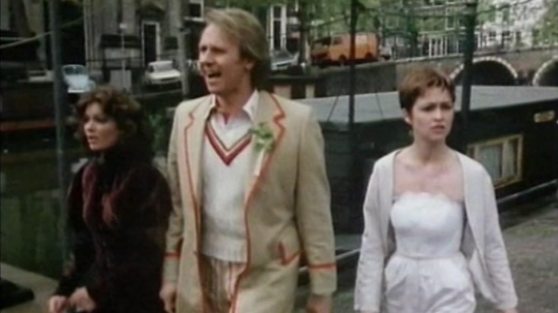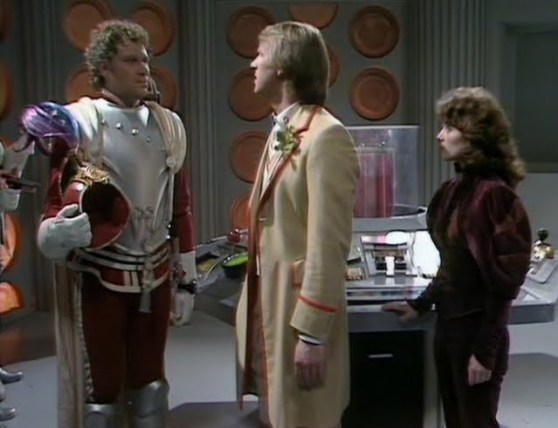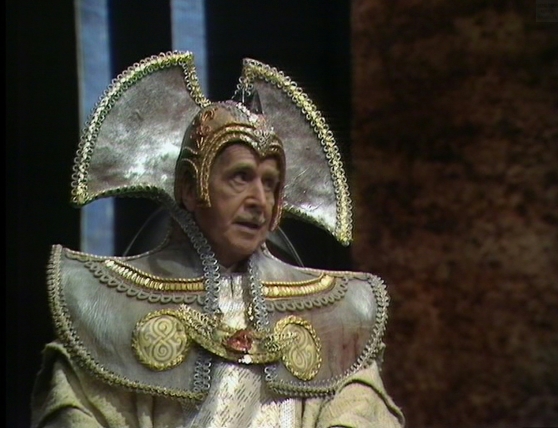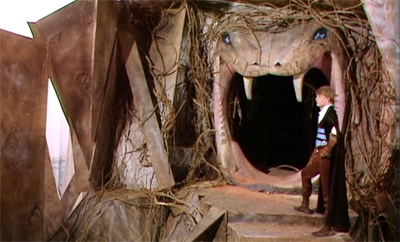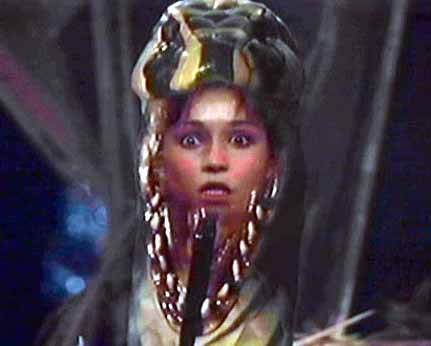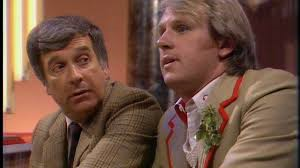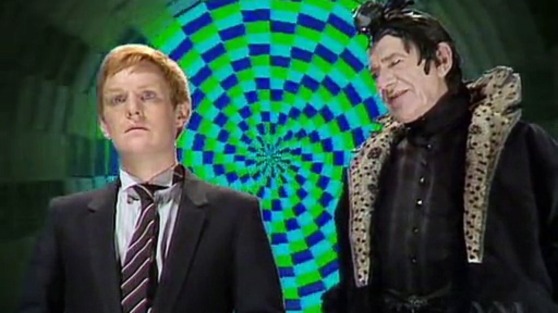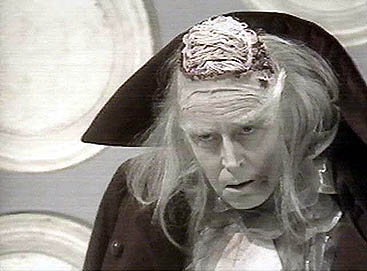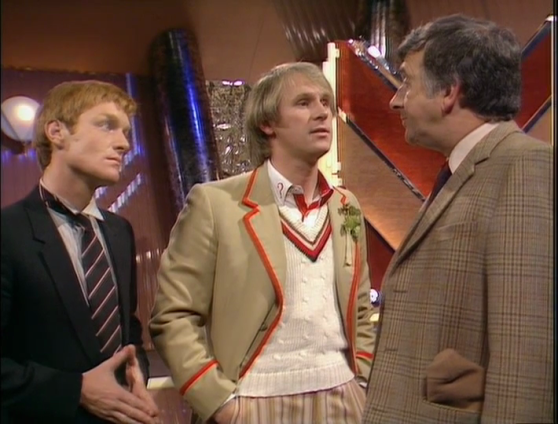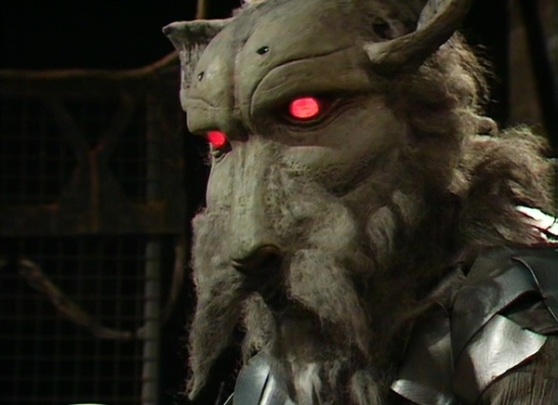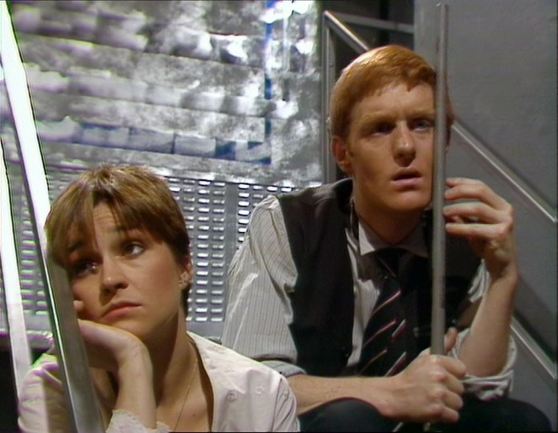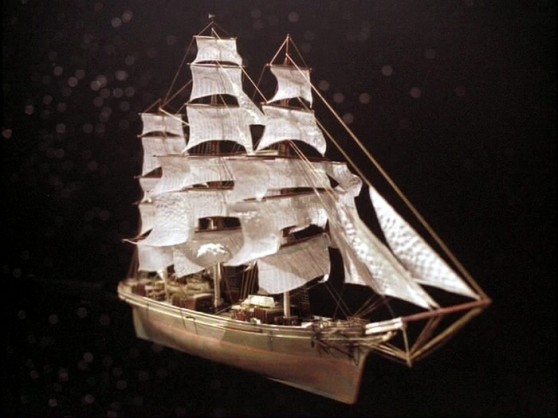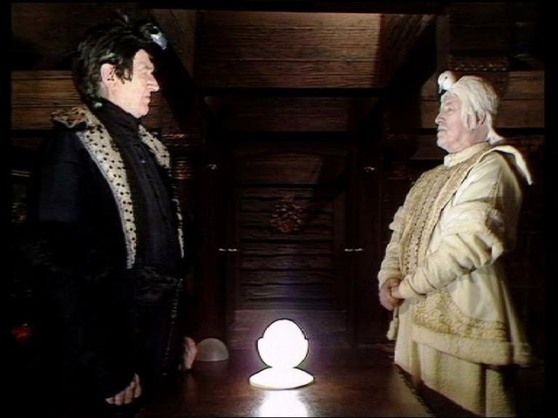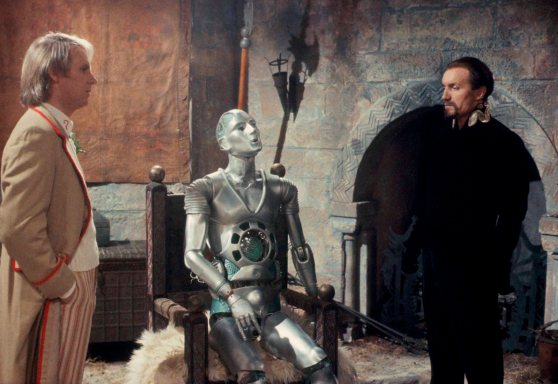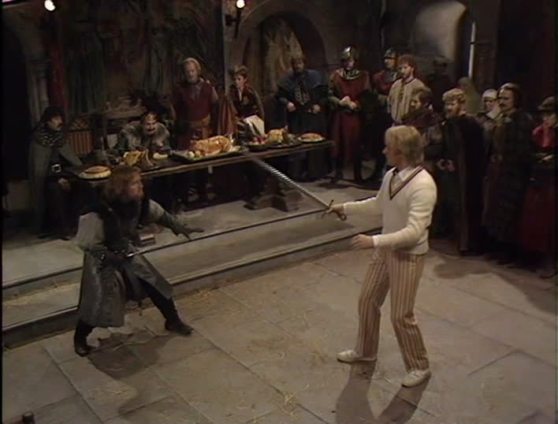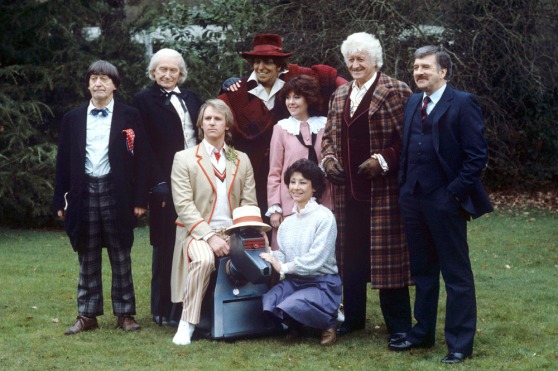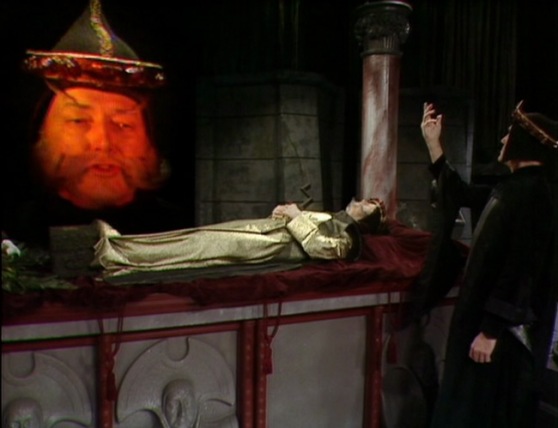It’s been a hectic few weeks behind the scenes, but today, we’re back, with our Classic Doctor Who rewatch, season twenty! Let’s get started!
I should mention at the outset that this is an anniversary season—twenty years, to be precise—and thus it’s a little different. This season is filled with appearances by villains and other references from the past seasons and incarnations of the Doctor, culminating with the very first official anniversary special, The Five Doctors. (The Three Doctors, while definitely an anniversary story, was technically not a special; it was a normal part of its season.) In our season opener, Arc of Infinity, it’s the villain and former Time Lord Omega, last seen in The Three Doctors—and once presumed dead. Here he returns, in a plan to retake our universe and punish the Time Lords—and he needs the Doctor to do it.
The plan is simple, but difficult. Omega wants to cross back into our universe, but as he remains in an antimatter state, he needs the body and biodata of a Time Lord to do so. In vengeance for his previous defeat, he chooses the Doctor as his target; but it quickly becomes clear that someone high in the Gallifreyan hierarchy is also involved, as only a Councilor can access the Matrix to retrieve the biodata. That someone, in the end, proves to be Councilor Hedin, who has been taken in by hero-worship of Omega, and wants to restore him, not believing the danger he represents. In the meantime, the High Council’s solution is simple and draconian: They will execute the Doctor. Without him, Omega cannot cross over.
By sheer coincidence—or perhaps not, given that Earth was the setting for The Three Doctors—Omega also has made contact with Earth in 1983 Amsterdam, and has hidden his (antimatter?!) TARDIS there. How he obtained such a TARDIS is never known, but it is clearly a more advanced model than the Doctor’s Type 40. Tegan Jovanka, having recently left the TARDIS and lost her job, stumbles into the situation and is captured by Omega for use as bait. In this manner she eventually rejoins the TARDIS crew. Omega is returned to his own universe, and the Doctor is permitted to go on his way.
Some observations: Borusa has regenerated again—he seems to go through them faster than the Doctor!—and has been named Lord President in the Doctor’s absence. There are also a new Castellan and a new Chancellery Guard Commander (played by a pre-Doctor Colin Baker!), replacing Andred. Neither Andred nor Leela are seen, though it is mentioned that they have married. Gallifrey seems to have relaxed its no-aliens policy, which I like to attribute to Leela. The High Council is considerably smaller in this era than it will be seen to be during the Time War (The End of Time); however it may be that, like the Senate and House in America, not every member must be present to be in session. The Doctor says to Maxil, “If I’m to die, I want to prepare myself mentally. For that I need to be alone.” This bit of dialogue could be taken as distant foreshadowing of the concept of a confession dial. And last, Peter Davison joins Hartnell, Troughton, and Baker in the tradition of playing both the Doctor and a villain in the same episode; he plays Omega’s short-lived form after transference, which shares the Doctor’s biodata.
Snakedance takes us to the planet Manussa in the year 3426, though it takes some mental gymnastics to work out evidence that the date is in Earth years; the planet is a former Earth colony, but with a convoluted history of its own, with two separate empires in its past. One of those empires is the Sumaran Empire, ruled by another past enemy: the Mara. That being exerts its influence over Tegan here, causing her to pilot the TARDIS to Manussa, and then taking control of her to bring itself back to the corporeal world. On Deva Loka, it seemed to lack the strength to control more than one person; here it suffers no such restriction, and quickly spreads its influence. It cannot be beaten with mirrors this time, and must be destroyed by the Doctor, who requires the aid of an old mystic named Dojjen.
The Doctor’s behavior here is uncharacteristically frantic and excitable; it’s very similar to the Eleventh Doctor. At one point he’s stuck in a cell; too bad he doesn’t have some kind of sonic device to use as a lockpick…nah, that’s just crazy talk. (Never thought I’d get to use THAT joke again. Even Nyssa jokes about it!) Having rejoined the TARDIS, Tegan shares a room with Nyssa, which is odd given the TARDIS’s internal volume; they seem to just like the company. Overall this story is well-written, and along with its prequel Kinda, it has traditionally been well-liked and enjoyed high ratings. It’s not my personal favorite Fifth Doctor story (after some thought, that would probably be The Visitation), but it’s high on the list.
Mawdryn Undead takes us back to Earth, and brings back a familiar face: Brigadier Alistair Gordon Lethbridge-Stewart. With that reference, though, the serial touches off the infamous UNIT dating controversy. To put it briefly—and I won’t go into all the details here—if the dates given in this serial are accurate, then none of the previously-given chronology for the UNIT stories (and by extension, all the way back to The Abominable Snowmen) can add up properly. We could easily have an entire post about this controversy; therefore I’ll just give the dates as noted in the story, and I’ll say that I just simply consider them incorrect (specifically, too early by several years). I take the vast majority of UNIT stories to be roughly contemporary with their broadcast dates, which this serial would not allow. To me, discarding the dates here is the easiest and simplest solution.
The story begins in 1983; its flashback scenes are set in 1977. It’s the beginning of the Black Guardian Trilogy, which sees the return of that villain, who wants to fulfill his long-ago promise to destroy the Doctor for his defeat in the Key to Time incident. The Black Guardian enlists the aid of a teenage schoolboy named Vislor Turlough, who has a secret of his own: he’s not from Earth. His true origin will not be revealed until next season. Turlough happens to be a student at Brendon Public School, where the now-retired Brigadier teaches mathematics. In exchange for a promise of freedom from Earth, Turlough willingly helps the Black Guardian in this and the next two stories, but balks at killing the Doctor; he’s not evil, just young and desperate. The Brigadier can’t remember his previous involvement with the Doctor at first; he believes this to be the result of a nervous breakdown in 1977, but in reality, it’s the Blinovitch Limitation Effect. Put another way, his past and present selves encounter each other, and upon physical contact, they short out the time differential between them; the resultant discharge of energy temporarily affects his memory. He is eventually set right by the Doctor.
The subplot from which the serial takes is title is that of Mawdryn, a scientist of a race which attempted to steal regeneration technology from the Time Lords. It backfired miserably, leaving him and his fellow scientists constantly dying, but never dead. They, too aren’t evil, only pitiable; they want the Doctor to willingly give up his regeneration energy—all his remaining lives, in the first hint that regeneration energy is even a thing—to allow them to die. When his companions are affected, he agrees to do so; but the Brigadiers’ discharge of temporal energy at the right moment powers Mawdryn’s machine and saves him the trouble. Afterward, Turlough joins the crew.
I don’t often talk about behind-the scenes situations, but in this story, the production team inteneded for Ian Chesterton to make an appearance. William Russell proved unavailable, unfortunately; however, we got the Brigadier instead, so I am not complaining. But, what a missed opportunity! Ian has long been one of my favorite companions.
Part two of the Black Guardian Trilogy, Terminus, takes us to the 35th century and the station of Terminus, parked at the approximate center of the universe. The TARDIS is sent there via sabotage by Turlough, who is still under the power of the Black Guardian. Terminus is allegedly a hospital facility for the sufferers of Lazar’s Disease, which has plagued the known universe. However, secretly it kills the sufferers. It used to have the ability to travel in time; it inadvertently created the universe when it traveled back too far and a hydrogen engine exploded, triggering the Big Bang. Tragically, that is NOT the story at hand here, and is only tangentially relevant; the Doctor must prevent a second such explosion which would destroy the universe. (The Doctor himself will be responsible for a “reboot” of the Big Bang in The Pandorica Opens/The Big Bang.)
The Guardian again fails to kill the Doctor, and grows more impatient with Turlough. Nyssa opts to leave the TARDIS here; she is first infected with Lazar’s Disease, then cured, and subsequently she chooses to stay behind and help the other sufferers. The Doctor, Tegan, and Turlough travel on without her.
Enlightenment wraps up the Black Guardian Trilogy, and sees the reappearance of the White Guardian for the first time since The Ribos Operation. It returns us to the Sol system, but not to Earth; rather it takes place on a collection of anachronistic ships in space, which are piloted by the Eternals. These beings are immortal, incorporeal (except by choice) and above mortal beings, but are not on the level of gods; they require a living being in order to think for themselves. In this, their only televised appearance, they race through the solar system in search of Enlightenment—true knowledge—which is guarded by the Black and White Guardians. One of them—Wrack, captain of the Buccaneer—is in league with the Black Guardian to cheat and win the race; Wrack will gain ultimate power, and the Black Guardian gains a final opportunity to destroy the Doctor. The tables are turned on him when the Doctor causes the death of Wrack, and Turlough uses the gem of enlightenment to destroy the Black Guardian (temporarily—as the White Guardian points out, he must always return).
To me this serial was the low point of the season, and I didn’t care for it. However, it sees Turlough, now free of the Black Guardian, join the TARDIS crew in truth, though he still has his own secrets. It adequately wraps up the Black Guardian arc, but felt flat as a story.
The King’s Demons is the true season finale, as the following story is a special which was released much later. It’s a historical, dealing with the signing of the Magna Carta, which happens offscreen. It sees the return of the Master, who brings with him a new companion, the robot Kamelion. Kamelion has the ability to impersonate anyone; the Master intends to impersonate King John and see him discredited, therefore preventing the signing, which will weaken human history. Okay, it’s kind of a weak plot for the Master. At any rate, Kamelion also has the weakness of being controllable by anyone with sufficient telepathic strength. As a result, at the end, he is freed by the Doctor and joins the crew; but he will only appear once more, spending the rest of his time hiding in the TARDIS to prevent being taken captive again.
The Doctor again shows off his swordsmanship, following in the footsteps of the Third and Fourth Doctors; while no other classic Doctor will do so, the Tenth Doctor will revive the tradition in The Christmas Invasion. The fight against the disguised Master was completed without stuntmen; Peter Davison and Anthony Ainley did all the sparring themselves. Again, the Master’s identity is concealed with a double anagram; the character is called “Sir Gilles Estram”, an anagram for Master, while the actor was credited as “James Stoker”, an anagram for “Master’s Joke”.
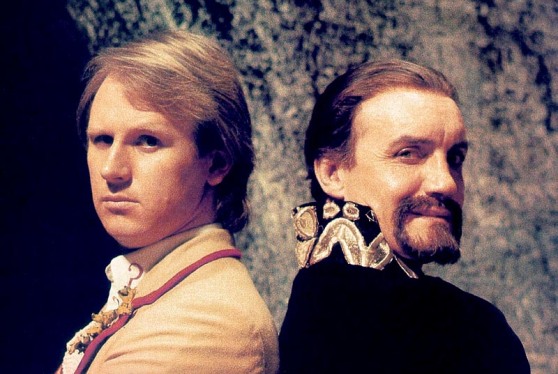
“Hey, Doctor.” “Yeah?” “You think they’ll figure out my identity this time?” “Not a chance, Estram, not a chance.”
This is an odd choice for season finale. In addition to being a fairly weak (but enjoyable) story for the Master, it’s also a two-parter, the only one of the season. On the other hand, part one is the 600th episode of the series; and it’s possible it may have been planned with the knowledge that there would be a special before next season.
For the twentieth anniversary special, we return to Gallifrey for The Five Doctors. It truly is an anniversary special, being broadcast (at least, in America, though oddly not in the UK) on 11/23/83, twenty years to the day after the show’s premiere. (British viewers would have to wait two days for their broadcast.) It’s also the first Children in Need fundraising special for Doctor Who, though the revived series has greatly expanded this tradition. Though it’s called The Five Doctors, in fact only four appeared in new footage; Tom Baker declined to appear so soon after the end of his tenure, a decision he has since stated he regrets. Fortunately, footage from the unused Shada was present, and reworked to give him a bit of coverage in which he and Romana II were caught in a time eddy, much as the First Doctor was in The Three Doctors. Also, sadly, William Hartnell had since passed away, and therefore his part was played by lookalike Richard Hurndall (who, unfortunately, has also died in the intervening years). A number of companions appear as well: Susan (now visibly older), Sarah Jane, Romana II, Tegan, Turlough, K9 Mark III (never before seen on the show, but seen in the failed pilot for K9 and Company) and the Brigadier, as well as (in illusionary form) Jamie, Zoe, Mike Yates, and Liz Shaw. K9’s appearance sets the stage for his appearance in NuWho’s School Reunion. The Third Doctor and Second Doctor appear to be snatched from near the end of their lives; the Second Doctor is visiting a UNIT reunion and reminiscing with the Brigadier, and the Third Doctor knows Sarah Jane and is somehow aware of the Fourth Doctor despite never having met him. All of the above characters are collected by the Time Scoop and taken to the Death Zone on Gallifrey, a relic of Gallifrey’s bloodthirsty past, which contains the tomb of Time Lord founder Rassilon.
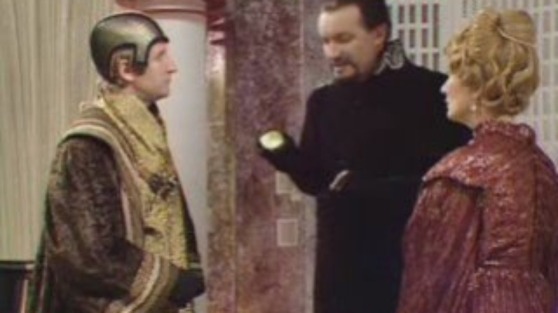
The Master, summoned! (Could not find a clearer picture. He is strangely absent from most of the pictures I found for this serial.)
The High Council summons the Master to rescue the Doctor, and promises him a new regeneration cycle as a reward. This is the first indication that they can grant such cycles. He takes them quite seriously, but most likely does not receive the regenerations here, although we know he will receive such a cycle in the Time War. It’s also an early indication that the Master’s relationship with the Doctor is deep and complex; he muses to the Council that “a cosmos without the Doctor scarcely bears thinking about.” He is instrumental in helping the Doctor, but in typical Master fashion—that is, through trickery and deception—and he escapes at the end. For once, he’s NOT the villain.
The Villain, as it turns out, is Borusa. Nearing the end of his life, he seeks immortality, which it is said that Rassilon discovered. He uses the Doctor’s various lives to clear the way to Rassilon’s Tower and tomb, and there encounters the mind of the fabled Time Lord himself; however, it proves to have all been a trap, when he accepts immortality only to find himself a living relief carved on Rassilon’s sarcophagus. Immortality, it seems, is too dangerous for anyone. The Doctor—in all his forms—quickly declines immortality, and leaves via the time scoop (though an unused ending would have had them all, with their companions, crowding into the TARDIS—I would have liked to see that!). Meanwhile, the Fifth Doctor becomes Lord President by default—and nimbly frees himself from the office, going on the run from his people once again. “After all, that’s how it all started.”
Things I enjoyed this season: Snakedance was a pleasure to watch, though it required a lot of attention. (I’m watching these serials in between tasks at work, so sometimes that is a challenge.) Tegan makes a wonderfully haughty villain, given that her usual personality alternates between mousy and whiny. Mwdryn Undead was great as well, and it was wonderful to see the Brigadier again. The dating of the story may have been clumsy, but the execution was great; any story that directly relies on time travel has the potential to be unworkable, but this one worked out well. I didn’t care for the rest of the Black Guardian Trilogy; a dozen times I was thinking “oh come on, the Doctor MUST know what Turlough is doing by now, even Tegan sees it!” The King’s Demons was a lot of fun, and while I’ve complained a bit that it’s not a very worthy plot for the Master, it was also nice to see something on a smaller scale. I liked Kamelion, and think the character deserves more development than he gets; it’s unfortunate that the prop was so difficult to use, limiting his appearances. And The Five Doctors was great all around. I suppose I may be easy to please, but I’ve enjoyed every multi-doctor story I’ve ever encountered, and this was no exception. Of course I wish that Tom Baker had appeared; but I think they covered it well, and not clumsily. The interaction between the various Doctors and their mismatched companions was something I would love to see more of (attention BBC: Please write a thirteen-Doctor story while these people are still alive! Get on it!).
Next season: Deaths everywhere, and the Doctor too! See you there.
All episodes may be viewed on Dailymotion; Links are Below



